Yesterday, I had a good, long rant about what an idiot I was to have signed up for a Crossfit Competition this weekend. However, today, I am feeling more philosophical about it.
Why?
Well, because of course the gal who is putting the Throwdown together is lovely, and talked me down from the ledge. But also, because This Crossfit Thing is really just so cool . . . and sometimes I forget that.
Let me explain.
Yesterday, I went into the box to meet with the gal putting the Throwdown together. As my blog yesterday stated, I signed up for a Crossfit competition this weekend in which there are three divisions, Rx (doing the full workout the way it’s supposed to be), Scaled (doing the full workout with lighter weights or some other tweaks), and “I want to participate but even Scaled is too daunting for me” (my division). When the events list came out, I had thought that this last category would be basically show up, lift a dumb bell the weight of a pom-pom, and get cheered for doing it. Nope. It is still the Scaled division, but if you can’t do one of the specific things in a workout, you get to swap it out.
But you’re “presumed” to do the Scaled unless you have to swap something out.
Just so you don’t have to click back and forth, here are the Rx WODs:
Workout 1:
Part A
5 minutes to build to 1 RM Clean and Jerk
Rest 1 minute to reset your bar.
Part B: 7 min AMRAP of
5 Handstand Pushups
7 Toes to Bar
5 Hang Power Cleans (40 kg)
Workout 2: For Time (8 Minute Time Cap):
100 meter run around a cone with sandbag (45#)
15 thruster (30 kg)
30 box jump (20″)
15 thruster
100 m run around a cone with sandbag
Workout 3:
2 min AMRAP/15 sec rest
3 min AMRAP/15 sec rest
4 min AMRAP
Row 10 Cal
15 pull up
20 wall ball (14 lbs)
25 double unders
30 burpee over rower
with any remaining time, row for Calories
Here are the substitutions for “Scaled”:
● Sub Hand Release Pushups (Games style) for Handstand pushups
● 7 toes to bar or 14 knees to chest (must be declared prior to the start of competition)
● Hang Power Clean 25 kg.
● Thruster 20KG.
● Run with 20 lb. wall ball versus 45# sandbag
● 15 jumping pull ups or 5 pull ups (selection must be declared prior to start of competition) – reverse/alternating grip permitted
● 25 double unders or 75 single unders (selection must be declared prior to start of competition)
Now, here’s where How Great Crossfit is, and ditto how great BeyondTheWhiteboard.com is, comes into play.
The idea of Crossfit is that you want to be able to do whatever the movement is at “Rx” (“as prescribed”). But Crossfit also believes that you should (1) get the movement exactly right, THEN (2) be able to do the movement exactly right, multiple times in a row and ONLY THEN (3) do the movement exactly right, multiple times in a row, at “intensity.” If you don’t have the movement exactly right (#1), then you “scale.” You do not move on to doing multiple movements, or adding weights, until you get the foundation down. “Scaling” means doing something that uses the same muscles as the Rx movement, but takes into account where you’re weak.
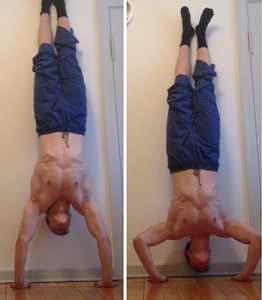 So, for example, let’s say that the Rx (taken from the above) is handstand pushups (HSPU). What that means is you do a handstand against the wall, then you dip your arms down until the top of your head hits the floor, and then you push back up until your arms are straight (one done…)
So, for example, let’s say that the Rx (taken from the above) is handstand pushups (HSPU). What that means is you do a handstand against the wall, then you dip your arms down until the top of your head hits the floor, and then you push back up until your arms are straight (one done…)
There are a LOT of ways to scale this movement. You could do it with your legs on a box. That would mean that you are basically lying on a box, bent over at the stomach, with your arms are straight and your head down the side of the box. You push up and down from there. (This means that the “leg part” of your body is supported/you’re not lifting it…plus, you don’t have to balance on your hands.)
A bit harder would be kneeling on the box, and then going over the side to do the HSPU. (Less stable, more “leg weight.”)
Or maybe you have trouble being upside down, so you do a “regular” pushup. Or maybe you don’t have a pushup at all, so you do a kneeling pushup. Or perhaps, because you want to actually work on the handstand portion v. the pushup portion, you do a “wall walk up” which means that you kick your feet up on the wall (facing the wall), and then walk your hands in toward the wall as far as you are comfortable going, then hold it for a certain amount of time.
Get the idea?
Well, so let’s look at the Rx above, and the Scale. It’s HSPU, with a Scale of “hand release pushups.” That means that you lie in a plank position (balanced on hands and toes, body straight), then bring your body all the way down until your chest touches the ground, then release your hands off the ground (basically you’re lying with your chest on the ground and you just pick your hands up off the ground), then put them back down, and push your body up until your arms are straight again (one done…)
Well, I can’t do that.
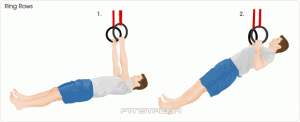 And kneeling (also known as “girls”) pushups are not the same sort of “movement” as a regular “plank pushup” – so that’s not a very good scale. So I was given two choices:
And kneeling (also known as “girls”) pushups are not the same sort of “movement” as a regular “plank pushup” – so that’s not a very good scale. So I was given two choices:
1. A “ring row.” What this means is that you’re lying basically under a set of rings hanging off a horizontal stanchion, and you “row” yourself up and then back down on the rings, arms locked out, chest “proud,” body straight (no “butt sag”).
 2. A “banded” pushup. In a “banded” pushup, you take what is basically a super duper strong elastic band, and you string it between two vertical stanchions. Then you lie over it, so the band is basically under your abdomen. You then do the regular hand release pushup, but part of your weight is supported by the band that you’re lying on.
2. A “banded” pushup. In a “banded” pushup, you take what is basically a super duper strong elastic band, and you string it between two vertical stanchions. Then you lie over it, so the band is basically under your abdomen. You then do the regular hand release pushup, but part of your weight is supported by the band that you’re lying on.
So, what did we do? I was timed to see “how long it took me” to do the pushups – it’s supposed to take everyone the same time. Then, we chose the elasticity of the band based on giving me enough “support” to do those pushups in the time that it should take me.
See? How great is that? This is why I love Crossfit. In a way, it’s like having a “handicap” in golf. Golf is one of the few sports where a true professional and a novice could play together, and there could be some prayer that the novice could beat (or at least come close to) the professional’s score. Your “handicap” is how many strokes you get to “take off of” your score (“strokes” meaning how  many hits it took you to get the ball into the hole). So if you have handicap of, say, 42, and you’re playing a pro golfer (with a handicap of zero), and he goes around the course and gets a score of 60, and you go around and get a score of 100, you win, because 100-42 is 58.
many hits it took you to get the ball into the hole). So if you have handicap of, say, 42, and you’re playing a pro golfer (with a handicap of zero), and he goes around the course and gets a score of 60, and you go around and get a score of 100, you win, because 100-42 is 58.
Similarly, in this Competition, they want the divisions to be giving the same “perceived exertion.” That means that (again, by way of example) if the Rx is a barbell move that is supposed to be at about 50% of that athlete’s one rep max, then you scale it at about 50% of YOUR one rep max. (e.g., if the Rx Crossfitter is lifting 100 pounds – which is 1/2 of 200 pounds, which is what she could lift only one time off the floor – and you can only lift 30 pounds one time off the floor because it’s so heavy, you do the move at 15 pounds – and each of your “perceived exertions” is the same.)
Or if, say, a bodyweight move is supposed to take about 30 seconds, then you scale the movement however you need to, so that you take 30 seconds.
Yesterday, I was doing all sorts of moves, trying to get moves that would be the same “perceived exertion” level as the Rx moves. So, where do you even start?
Our gym subscribes to Beyond The Whiteboard for us. It’s an online journal, where you log whatever you do that day and (this is the awesome part), it then keeps track of it all for you, and even shows you where you need some extra work. So, for example, if you’re doing back squats, you can pull up all the back squats you have done before, and they are all there for you. Moreover, it will show you all your squats together, and if you are doing a lot lower weight than someone “generally would” in the squat “family” it recommends you add more to that part of your programming.
Beyond The Whiteboard logs every move, and also every one of the “Girls” or “Heroes” or “other known” workouts (e.g., Nasty Girls). (Never mind all that, if you’re not a Crossfitter.)
The founder of Crossfit very strongly believes that you can’t get better at something you can’t measure. And the owner of our gym has given us this tool to do so. Before Beyond The Whiteboard, I kept track of my workouts in a journal and an Excel sheet. But the problem with that is (a) it’s time consuming, and (b) it’s not easy to “go back to the last time” you did a move, and figure out how you’re going to approach that move this time. It also doesn’t show you a “movement family” and where you might want to concentrate your future workouts.
And – because you not only track every movement, but you can also write yourself personal notes, etc. – you can immediately go back and see what you said to do “next time you did that move.” Genius. Pure Genius. It allows you to tell your “future self,” for example, that when you did the 5 sets of 5 repetitions of the back squat this time, you started at 15kg, and it was too light. So you won’t start that light again, you’ll start with some weight on that 15k bar.
 Otherwise, you’re just guessing.
Otherwise, you’re just guessing.
So, what did we figure out for my “Scales of the Scales”? Here you go:
Workout 1:
Part A
5 minutes to build to 1 RM Clean and Jerk – Rest 1 minute to reset your bar.
I am doing this as is. I can do a Clean and Jerk – Sure, I can’t do it particularly well, but that’s not the issue. I can do it. So we went through Beyond The Whiteboard on my previous Clean and Jerks, to discuss where I would start at, to be sure I had the right weights on the day. (In case you care, I’m starting at 20 kg.)
Part B: 7 min AMRAP of
5 Handstand Pushups – As I mentioned above, I’ll be doing 5 banded pushups, using the black band for support.
7 Toes to Bar – I am doing the 14 “knees up” scale – turns out you don’t need to get your knees all the way up TO your chest, only “break parallel” with your knees. It’s hard, but I can do that. Hello, abs…
5 Hang Power Cleans (40 kg) – I can do a hang power clean. I most assuredly can’t do it at 40kg, but the Scaled is 25kg. That’s a good bit of weight, but I can do it, so I will do it. The only issue here is that I will want to do Part A with a 20kg bar (my hands are huge), but that makes it difficult to put the “extra 5 kg” on it for Part B. As such, there will need to be 2 bars there for me, which was noted, so that when they are setting up for me it will all be there (cool, huh?).
Workout 2: For Time (8 Minute Time Cap):
 100 meter run around a cone with sandbag (45#) – Scaled is a 20lb. wall ball. Tell you the truth, I’d rather run not quite so far, and use the sandbag. Carrying a wall ball is SO MUCH HARDER than carrying a sandbag! A sandbag you can just drape over your shoulder – I practiced yesterday, and for goodness’ sakes . . . the wall ball is a lot harder! Ah well, so it goes ;-) I am not supposed to run (doctor’s orders because of all the metabolic issues I’ve blogged about ad nauseum), but I’ll walk fast. Or trot. I asked if I could do it with the 45# sandbag, but part of the issue is that we don’t have enough of them. So – wall ball it is.
100 meter run around a cone with sandbag (45#) – Scaled is a 20lb. wall ball. Tell you the truth, I’d rather run not quite so far, and use the sandbag. Carrying a wall ball is SO MUCH HARDER than carrying a sandbag! A sandbag you can just drape over your shoulder – I practiced yesterday, and for goodness’ sakes . . . the wall ball is a lot harder! Ah well, so it goes ;-) I am not supposed to run (doctor’s orders because of all the metabolic issues I’ve blogged about ad nauseum), but I’ll walk fast. Or trot. I asked if I could do it with the 45# sandbag, but part of the issue is that we don’t have enough of them. So – wall ball it is.
15 thruster (30 kg) – a “thruster” is the crazy-*ss movement shown in the image with three photos. I can’t do a squat, much less get the whole “dip under the bar” thing going. This was another one where we had to work on what I would “Scale to” for quite a while. I will be doing a sumo deadlift high pull with a 1.5 pood (54 pound) kettlebell. That’s the image with the four photos showing the four judging points. 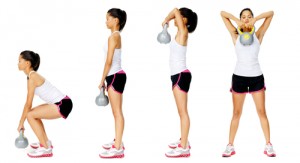
30 box jump (20″) – 20″ is not supposed to be a “high” box jump. So once again, we went to Beyond The Whiteboard to see what my “best” box jump ever was (18″) and what my “standard” box jump is (15″) and she said that it should be about 70% of my standard box jump. So I’m jumping up on two 25k plates with a 10k plate sandwiched in between (we literally measured it with a tape measure).
15 thruster – as above.
100 m run around a cone with sandbag – as above.
Workout 3:
2 min AMRAP/15 sec rest
3 min AMRAP/15 sec rest
4 min AMRAP
Row 10 Cal – this is the same.
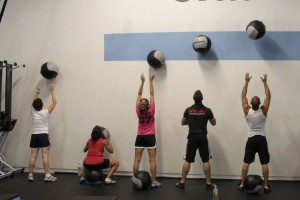 15 pull up – We decided I should do 5 banded pullups. I had to do banded pullups again and again until I could do the pullups in the time frame that an Rx athlete would generally do 15 kipping/butterfly/regular ones. This is going to be a pullup with a blue and red band for me. Though jumping pullups is an option (where you start with the pull up bar at about wrist level and use your legs to “jump” your chin over the bar), they really hurt my elbows on the way down. With banded pullups, I still have “support” on the “downstroke.”
15 pull up – We decided I should do 5 banded pullups. I had to do banded pullups again and again until I could do the pullups in the time frame that an Rx athlete would generally do 15 kipping/butterfly/regular ones. This is going to be a pullup with a blue and red band for me. Though jumping pullups is an option (where you start with the pull up bar at about wrist level and use your legs to “jump” your chin over the bar), they really hurt my elbows on the way down. With banded pullups, I still have “support” on the “downstroke.”
20 wall ball (14 lbs) – I can do wall balls so long as I have another wall ball to squat down to. This is a huge improvement for me. So I am doing this “Rx” but with another wall ball on the floor. Shame there is jumping rope afterwards, or I’d wear my (shiny newish) lifters to give me more “help” on the squat. 14 pounds is hard (I’ve never done wall balls with more than 10 pounds). But when I was doing it, she said I should do the 14. So I’m doing the 14.
25 double unders – I’ll be doing the scale, which is 75 single unders (A “single under” is jumping rope. A “double under” is jumping rope but the rope passes twice under your feet for each one jump. I am getting better at them – but if I have a single under Scale available, I’ll take it!)
30 burpee over rower – I can’t jump over the rower (I talked about this in the blog yesterday), but the gal putting the Throwdown together just laughed at me. She said, “Do you realize that basically if anyone gets any burpees in, they’re going to be a rock star?” I then looked at the workout, which is “as many rounds as possible” of these moves in the time cap of 2, then 3, then 4 minutes (but with only a 15 second rest), and I had to laugh too. We decided though that “in case” I get to the burpees, I can just do burpees. Since my burpees involve kneeling down, throwing myself onto the floor, then walking my feet back up, she dutifully noted I would need an Ab Mat for my knees.
with any remaining time, row for Calories – ha, ha, ha ;-)
So that’s my scales, folks. I feel a lot better now than I did yesterday. You know why I feel better, too? Because I saw one of the scaled male athletes today at the gym – he has a “frozen shoulder” so there is just no way he can do overhead movements correctly. (Stephanie, our WOD Recovery Yoga leader from Endure Yoga, talked about him today on the Girls Gone WOD Podcast, in fact.) And whereas his girlfriend, who is doing the Throwdown too, said she would be “laughing all day” at the whole thing, he and I can’t sleep. At least there is someone else out there feeling a little stressed out about this. (Made me feel better – what’s that saying, “Misery Loves Company”? ;-) )
SO RELIEVED how this worked out! Now, of course, we’ll see what happens on Saturday. Heck, I might not be able to lift the bar at all in the Clean & Jerk, etc. – but that’s just how Competition goes.
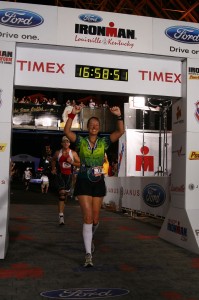 When I was training for the Ironman, someone said that you might, or you might not, make it over the finish line on actual race day, but you are ready to. You are “prepared” to do it. Whether or not you do your “best” or cross that finish line on that “particular day” is somewhat a matter of luck (or, as us lawyers say, “force majeure”).
When I was training for the Ironman, someone said that you might, or you might not, make it over the finish line on actual race day, but you are ready to. You are “prepared” to do it. Whether or not you do your “best” or cross that finish line on that “particular day” is somewhat a matter of luck (or, as us lawyers say, “force majeure”).
I’m going to try to keep that thought in my head. ;-)

